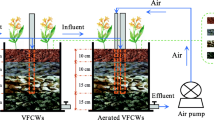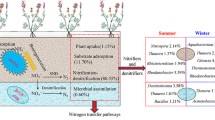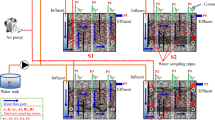Abstract
Four vertical-flow CWs (VFCWs) with different substrates and aeration conditions were studied on nutrient-removal capacity from synthetic wastewater. Zeolite substrate VFCWs (none-aerated: VFCW-1, aerated: VFCW-3) paralleled with ceramsite (none-aerated:VFCW-2, aerated: VFCW-4) were used to study the removal efficiencies of N and organics, the bacterial community, and the related functional genes. The results indicated that the pollutant removal efficiency was significantly enhanced by intermittent aeration. VFCW-4 (ceramsite with aeration) demonstrated a significant potential to remove NH4+-N (89%), NO3–-N (78%), TN (71%), and COD (65%). VFCW-3 and VFCW-4 had high abundances of Amx, amoA, and nirK genes, which was related to NH4+-N and NO2–-N removal. The microbial diversity and structure varied with aeration and substrate conditions. Proteobacteria, Actinobacteria, Candidatus, and Acidobacteria were the main bacteria phyla, with the average proportion of 38%, 21%, 19%, and 7% in the VFCWs. Intermittent aeration increased the abundance of Acidobacteria, which was conducive to the removal of organic matters. Overall, ceramsite substrate combined with intermittent aeration has a great potential in removing pollutants in VFCWs.





Similar content being viewed by others
Data availability
The datasets used and/or analyzed during the current study are available from the corresponding author on reasonable request.
References
Al-Wahaibi BM, Jafary T, Al-Mamun A, Baawain MS, Aghbashlo M, Tabatabaei M, Stefanakis AI (2021) Operational modifications of a full-scale experimental vertical flow constructed wetland with effluent recirculation to optimize total nitrogen removal. J Cleaner Prod;296. https://doi.org/10.1016/j.jclepro.2021.126558
APHA (2005) Standard Methods for the Examination of Water and Wastewater, twentyfirsted. American Public Health Association, Washington, DC
Bai S, Qin L, Liu L, Gao X, Ding Y, Li Y (2021) Effect of substrate types on contaminant removals, electrochemical characteristics and microbial community in vertical flow constructed wetlands for treatment of urban sewage. J Environ Manage 280:111682. https://doi.org/10.1016/j.jenvman.2020.111682
Boog J, Nivala J, Aubron T, Wallace S, van Afferden M, Muller RA (2014) Hydraulic characterization and optimization of total nitrogen removal in an aerated vertical subsurface flow treatment wetland. Bioresour Technol 162:166–174. https://doi.org/10.1016/j.biortech.2014.03.100
Bruch I, Fritsche J, Banninger D, Alewell U, Sendelov M, Hurlimann H, Hasselbach R, Alewell C (2011) Improving the treatment efficiency of constructed wetlands with zeolite-containing filter sands. Bioresour Technol 102(2):937–941. https://doi.org/10.1016/j.biortech.2010.09.041
Cao Q, Wang H, Chen X, Wang R, Liu J (2017) Composition and distribution of microbial communities in natural river wetlands and corresponding constructed wetlands. Ecol Eng 98:40–48. https://doi.org/10.1016/j.ecoleng.2016.10.063
Chand N, Kumar K, Suthar S (2021) “Cattle dung biochar-packed vertical flow constructed wetland for nutrient removal”: Effect of intermittent aeration and wastewater COD/N loads on the removal process. J Water Process Eng;43. https://doi.org/10.1016/j.jwpe.2021.102215
Chen C, Xu XJ, Xie P, Yuan Y, Zhou X, Wang AJ, Lee DJ, Ren NQ (2017) Pyrosequencing reveals microbial community dynamics in integrated simultaneous desulfurization and denitrification process at different influent nitrate concentrations. Chemosphere 171:294–301. https://doi.org/10.1016/j.chemosphere.2016.11.159
Chen TY, Kao CM, Yeh TY, Chien HY, Chao AC (2006) Application of a constructed wetland for industrial wastewater treatment: a pilot-scale study. Chemosphere 64(3):497–502. https://doi.org/10.1016/j.chemosphere.2005.11.069
Cheng S, Qin C, Xie H, Wang W, Zhang J, Hu Z, Liang S (2021) Comprehensive evaluation of manganese oxides and iron oxides as metal substrate materials for constructed wetlands from the perspective of water quality and greenhouse effect. Ecotoxicol Environ Saf 221:112451. https://doi.org/10.1016/j.ecoenv.2021.112451
Dong H, Qiang Z, Li T, Jin H, Chen W (2012) Effect of artificial aeration on the performance of vertical-flow constructed wetland treating heavily polluted river water. J Environ Sci 24(4):596–601. https://doi.org/10.1016/s1001-0742(11)60804-8
Dotro G, Langergraber G, Molle P, Nivala J, Puigagut J, Stein OR, von Sperling M (2017) Treatment Wetlands, vol. 7, Biological Wastewater Treatment Series, IWA Publishing, London, UK
Fan J, Liang S, Zhang B, Zhang J (2013a) Enhanced organics and nitrogen removal in batch-operated vertical flow constructed wetlands by combination of intermittent aeration and step feeding strategy. Environ Sci Pollut Res Int 20(4):2448–2455. https://doi.org/10.1007/s11356-012-1130-7
Fan J, Zhang B, Zhang J, Ngo HH, Guo W, Liu F, Guo Y, Wu H (2013b) Intermittent aeration strategy to enhance organics and nitrogen removal in subsurface flow constructed wetlands. Bioresour Technol 141:117–122. https://doi.org/10.1016/j.biortech.2013.03.077
Faulwetter JL, Gagnon V, Sundberg C, Chazarenc F, Burr MD, Brisson J, Camper AK, Stein OR (2009) Microbial processes influencing performance of treatment wetlands: A review. Ecol Eng 35(6):987–1004. https://doi.org/10.1016/j.ecoleng.2008.12.030
Ji Z, Tang W, Pei Y (2022) Constructed wetland substrates: a review on development, function mechanisms, and application in contaminants removal. Chemosphere 286(Pt 1):131564. https://doi.org/10.1016/j.chemosphere.2021.131564
Jia L, Wang R, Feng L, Zhou X, Lv J, Wu H (2018) Intensified nitrogen removal in intermittently-aerated vertical flow constructed wetlands with agricultural biomass: effect of influent C/N ratios. Chem Eng J 345:22–30. https://doi.org/10.1016/j.cej.2018.03.087
Jiao K, Yang B, Wang H, Xu W, Zhang C, Gao Y, Sun W, Li F, Ji D (2022) The individual and combined effects of polystyrene and silver nanoparticles on nitrogen transformation and bacterial communities in an agricultural soil. Sci Total Environ 820:153358. https://doi.org/10.1016/j.scitotenv.2022.153358
John Y, Langergraber G, Adyel TM, Emery David V, Jr. (2020) Aeration intensity simulation in a saturated vertical up-flow constructed wetland. Sci Total Environ 708:134793. https://doi.org/10.1016/j.scitotenv.2019.134793
Kozjek K, Manoharan L, Ahrén D, Hedlund K (2022) Microbial functional genes influenced by short-term experimental drought across European agricultural fields. Soil Biol Biochem;168. https://doi.org/10.1016/j.soilbio.2022.108650
Langergraber G, Pressl A, Leroch K, Rohrhofer R, Haberl R (2010) Comparison of single-stage and a two-stage vertical flow constructed wetland systems for different load scenarios. Water Sci Technol 61:1341–1348. https://doi.org/10.2166/wst.2010.024
Langergraber G, Dotro G, Nivala J, Stein OR, Rizzo A (2019) Wetland Technology: Practical information on the design and application of treatment wetlands. IWA Publishing, London
Lai X, Zhao Y, Pan F, Yang B, Wang H, Wang S, He F (2020a) Enhanced optimal removal of nitrogen and organics from intermittently aerated vertical flow constructed wetlands: Relative COD/N ratios and microbial responses. Chemosphere 244:125556. https://doi.org/10.1016/j.chemosphere.2019.125556
Lai X, Zhao Y, Pan F, Yang B, Wang H, Wang S, Yuan Y (2020b) Enhanced nitrogen removal in filled-and-drained vertical flow constructed wetlands: microbial responses to aeration mode and carbon source. Environ Sci Pollut Res Int 27(30):37650–37659. https://doi.org/10.1007/s11356-020-09915-6
Liu H, Hu Z, Zhang J, Ngo HH, Guo W, Liang S, Fan J, Lu S, Wu H (2016) Optimizations on supply and distribution of dissolved oxygen in constructed wetlands: a review. Bioresour Technol 214:797–805. https://doi.org/10.1016/j.biortech.2016.05.003
Liu M, Wu S, Chen L, Dong R (2014) How substrate influences nitrogen transformations in tidal flow constructed wetlands treating high ammonium wastewater? Ecol Eng 73:478–486. https://doi.org/10.1016/j.ecoleng.2014.09.111
Lyu T, He K, Dong R, Wu S (2018) The intensified constructed wetlands are promising for treatment of ammonia stripped effluent: nitrogen transformations and removal pathways. Environ Pollut 236:273–282. https://doi.org/10.1016/j.envpol.2018.01.056
Manirakiza B, Zhang S, Addo FG, Isabwe A, Nsabimana A (2022) Exploring microbial diversity and ecological function of epiphytic and surface sediment biofilm communities in a shallow tropical lake. Sci Total Environ 808:151821. https://doi.org/10.1016/j.scitotenv.2021.151821
Mawang CI, Azman AS, Fuad AM, Ahamad M (2021) Actinobacteria: an eco-friendly and promising technology for the bioaugmentation of contaminants. Biotechnol Rep (amst) 32:e00679. https://doi.org/10.1016/j.btre.2021.e00679
Meng P, Pei H, Hu W, Shao Y, Li Z (2014) How to increase microbial degradation in constructed wetlands: influencing factors and improvement measures. Bioresour Technol 157:316–326. https://doi.org/10.1016/j.biortech.2014.01.095
Nivala J, Boog J, Headley T, Aubron T, Wallace S, Brix H, Mothes S, van Afferden M, Muller RA (2019) Side-by-side comparison of 15 pilot-scale conventional and intensified subsurface flow wetlands for treatment of domestic wastewater. Sci Total Environ 658:1500–1513. https://doi.org/10.1016/j.scitotenv.2018.12.165
Ong SA, Uchiyama K, Inadama D, Ishida Y, Yamagiwa K (2010) Performance evaluation of laboratory scale up-flow constructed wetlands with different designs and emergent plants. Bioresour Technol 101(19):7239–7244. https://doi.org/10.1016/j.biortech.2010.04.032
Pan J, Qi S, Sun Y, Jiang Y, Zhao N, Huang L, Sun Y (2017) Nitrogen removal and nitrogen functional gene abundances in three subsurface wastewater infiltration systems under different modes of aeration and influent C/N ratios. Bioresour Technol 241:1162–1167. https://doi.org/10.1016/j.biortech.2017.05.112
Pascual A, Pena R, Gómez-Cuervo S, de la Varga D, Alvarez JA, Soto M, Arias CA (2021) Nature based solutions for winery wastewater valorisation. Ecol Eng;169. https://doi.org/10.1016/j.ecoleng.2021.106311
Pelissari C, Guivernau M, Vinas M, Garcia J, Velasco-Galilea M, Souza SS, Sezerino PH, Avila C (2018) Effects of partially saturated conditions on the metabolically active microbiome and on nitrogen removal in vertical subsurface flow constructed wetlands. Water Res 141:185–195. https://doi.org/10.1016/j.watres.2018.05.002
Pucher B, Langergraber G (2019) Influence of design parameters on the treatment performance of VF wetlands - a simulation study. Water Sci Technol 80(2):265–273. https://doi.org/10.2166/wst.2019.268
Pucher B, Ruiz H, Paing J, Chazarenc F, Molle P, Langergraber G (2017) Using numerical simulation of a one stage vertical flow wetland to optimize the depth of a zeolite layer. Water Sci Technol 75(3–4):650–658. https://doi.org/10.2166/wst.2016.545
Ren W, Cao F, Ju K, Tang F, Chai B, Li S, Jin P (2021) Regulatory strategies and microbial response characteristics of single-level biological aerated filter-enhanced nitrogen removal. J Water Process Eng;42. https://doi.org/10.1016/j.jwpe.2021.102190
Saeed T, Sun G (2012) A review on nitrogen and organics removal mechanisms in subsurface flow constructed wetlands: dependency on environmental parameters, operating conditions and supporting media. J Environ Manage 112:429–448. https://doi.org/10.1016/j.jenvman.2012.08.011
Santos F, Almeida CMR, Ribeiro I, Ferreira AC, Mucha AP (2019) Removal of veterinary antibiotics in constructed wetland microcosms - response of bacterial communities. Ecotoxicol Environ Saf 169:894–901. https://doi.org/10.1016/j.ecoenv.2018.11.078
Stefanakis AI, Tsihrintzis VA (2012a) Effects of loading, resting period, temperature, porous media, vegetation and aeration on performance of pilot-scale vertical flow constructed wetlands. Chem Eng J 181–182:416–430. https://doi.org/10.1016/j.cej.2011.11.108
Stefanakis AI, Tsihrintzis VA (2012b) Use of zeolite and bauxite as filter media treating the effluent of vertical flow constructed wetlands. Microporous Mesoporous Mater 155:106–116. https://doi.org/10.1016/j.micromeso.2012.01.022
Tatoulis T, Akratos CS, Tekerlekopoulou AG, Vayenas DV, Stefanakis AI (2017) A novel horizontal subsurface flow constructed wetland: reducing area requirements and clogging risk. Chemosphere 186:257–268. https://doi.org/10.1016/j.chemosphere.2017.07.151
Tong X, Wang X, He X, Xu K, Mao F (2019) Effects of ofloxacin on nitrogen removal and microbial community structure in constructed wetland. Sci Total Environ 656:503–511. https://doi.org/10.1016/j.scitotenv.2018.11.358
Tsihrintzis VA (2017) The use of Vertical Flow Constructed Wetlands in Wastewater Treatment. Water Resour Manage 31(10):3245–3270. https://doi.org/10.1007/s11269-017-1710-x
Wang H, Ji G, Bai X (2015a) Enhanced long-term ammonium removal and its ranked contribution of microbial genes associated with nitrogen cycling in a lab-scale multimedia biofilter. Bioresour Technol 196:57–64. https://doi.org/10.1016/j.biortech.2015.07.055
Wang H, Ji G, Bai X, He C (2015b) Assessing nitrogen transformation processes in a trickling filter under hydraulic loading rate constraints using nitrogen functional gene abundances. Bioresour Technol 177:217–223. https://doi.org/10.1016/j.biortech.2014.11.094
Wang P, Zhang H, Zuo J, Zhao D, Zou X, Zhu Z, Jeelani N, Leng X, An S (2016) A hardy plant facilitates nitrogen removal via microbial communities in subsurface flow constructed wetlands in winter. Sci Rep 6:33600. https://doi.org/10.1038/srep33600
Weber KP, Legge RL (2011) Dynamics in the bacterial community-level physiological profiles and hydrological characteristics of constructed wetland mesocosms during start-up. Ecol Eng 37:666–677. https://doi.org/10.1016/j.ecoleng.2010.03.016
Wu H, Fan J, Zhang J, Ngo HH, Guo W, Hu Z, Liang S (2015a) Decentralized domestic wastewater treatment using intermittently aerated vertical flow constructed wetlands: impact of influent strengths. Bioresour Technol 176:163–168. https://doi.org/10.1016/j.biortech.2014.11.041
Wu H, Fan J, Zhang J, Ngo HH, Guo W, Liang S, Lv J, Lu S, Wu W, Wu S (2016) Intensified organics and nitrogen removal in the intermittent-aerated constructed wetland using a novel sludge-ceramsite as substrate. Bioresour Technol 210:101–107. https://doi.org/10.1016/j.biortech.2016.01.051
Wu S, Qi Y, Yue Q, Gao B, Gao Y, Fan C, He S (2015b) Preparation of ceramic filler from reusing sewage sludge and application in biological aerated filter for soy protein secondary wastewater treatment. J Hazard Mater 283:608–616. https://doi.org/10.1016/j.jhazmat.2014.10.013
Yang Z, Yang L, Wei C, Wu W, Zhao X, Lu T (2018) Enhanced nitrogen removal using solid carbon source in constructed wetland with limited aeration. Bioresour Technol 248(Pt B):98–103. https://doi.org/10.1016/j.biortech.2017.07.188
Yang JX, Feng L, Pi SS, Cui D, Ma F, Zhao HP et al (2020) A critical review of aerobic denitrification: insights into the intracellular electron transfer. Sci Total Environ 731:139080. https://doi.org/10.1016/j.scitotenv.2020.139080
Yuan Y, Yang B, Wang H, Lai X, Li F, Salam MMA, Pan F, Zhao Y (2020) The simultaneous antibiotics and nitrogen removal in vertical flow constructed wetlands: Effects of substrates and responses of microbial functions. Bioresour Technol 310:123419. https://doi.org/10.1016/j.biortech.2020.123419
Zhang F, Peng Y, Miao L, Wang Z, Wang S, Li B (2017) A novel simultaneous partial nitrification Anammox and denitrification (SNAD) with intermittent aeration for cost-effective nitrogen removal from mature landfill leachate. Chem Eng J 313:619–628. https://doi.org/10.1016/j.cej.2016.12.105
Zhang K, Yang S, Luo H, Chen J, An X, Chen W, Zhang X (2022) Enhancement of nitrogen removal and energy recovery from low C/N ratio sewage by multi-electrode electrochemical technology and tidal flow via siphon aeration. Chemosphere 299:134376. https://doi.org/10.1016/j.chemosphere.2022.134376
Zhang X, Hu Z, Ngo HH, Zhang J, Guo W, Liang S, Xie H (2018) Simultaneous improvement of waste gas purification and nitrogen removal using a novel aerated vertical flow constructed wetland. Water Res 130:79–87. https://doi.org/10.1016/j.watres.2017.11.061
Zhao X, Wang R, Dong L, Li W, Li M, Wu H (2021) Simultaneous removal of nitrogen and dimethyl phthalate from low-carbon wastewaters by using intermittently-aerated constructed wetlands. J Hazard Mater 404(Pt A):124130. https://doi.org/10.1016/j.jhazmat.2020.124130
Zhi W, Yuan L, Ji G, He C (2015) Enhanced long-term nitrogen removal and its quantitative molecular mechanism in tidal flow constructed wetlands. Environ Sci Technol 49(7):4575–4583. https://doi.org/10.1021/acs.est.5b00017
Zhu W-L, Cui L-H, Ouyang Y, Long C-F, Tang X-D (2011) Kinetic adsorption of ammonium nitrogen by substrate materials for constructed wetlands. Pedosphere 21(4):454–463. https://doi.org/10.1016/s1002-0160(11)60147-1
Funding
This research was funded by the National Natural Science Foundation of China (41877424; 32071559; 51904116), the Research Leader Studio Project (2021GXRC094), the Key R&D project of Shandong Province (2021LZGC005-02–02), and the Fundamental Research Funds for the Central Universities, CHD (300102351505).
Author information
Authors and Affiliations
Contributions
Wenxue Xu: writing—original draft, preparation, formal analysis, investigation, conceptualization. Baoshan Yang: methodology, resources, project administration. Hui Wang: writing—review and editing, conceptualization, resources, funding acquisition, project administration. Shuzhi Wang: methodology and measurement. Feng Li: methodology. Keqin Jiao: validation. Chuanfeng Zhang: validation. Haixia Wang: revision.
Corresponding author
Ethics declarations
Ethical approval.
This article does not contain any studies with human participants or animals performed by any of the authors.
Consent to participate
Not applicable.
Consent for publication
Not applicable.
Conflict of interest
The authors declare no competing interests.
Additional information
Responsible Editor: Alexandros Stefanakis
Publisher's note
Springer Nature remains neutral with regard to jurisdictional claims in published maps and institutional affiliations.
Supplementary Information
Below is the link to the electronic supplementary material.
Rights and permissions
Springer Nature or its licensor (e.g. a society or other partner) holds exclusive rights to this article under a publishing agreement with the author(s) or other rightsholder(s); author self-archiving of the accepted manuscript version of this article is solely governed by the terms of such publishing agreement and applicable law.
About this article
Cite this article
Xu, W., Yang, B., Wang, H. et al. Improving the removal efficiency of nitrogen and organics in vertical-flow constructed wetlands: the correlation of substrate, aeration and microbial activity. Environ Sci Pollut Res 30, 21683–21693 (2023). https://doi.org/10.1007/s11356-022-23746-7
Received:
Accepted:
Published:
Issue Date:
DOI: https://doi.org/10.1007/s11356-022-23746-7




